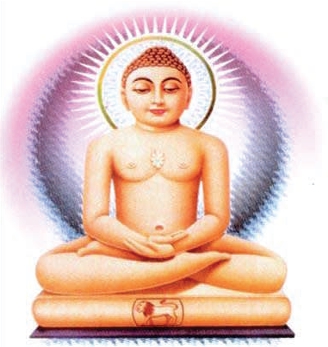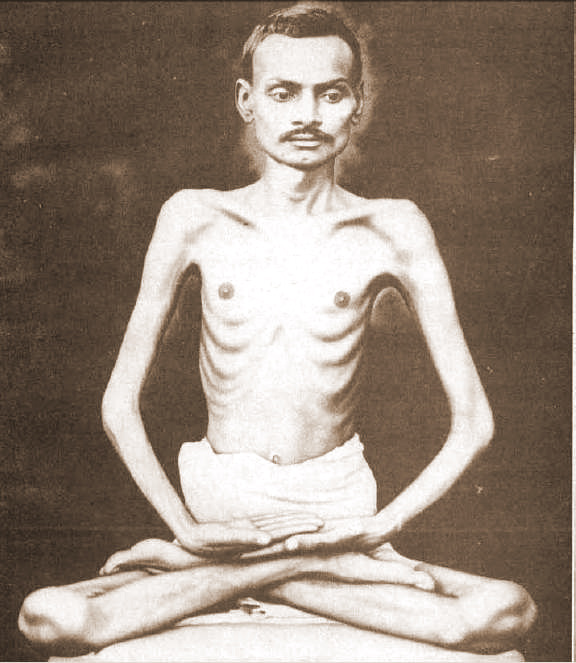
History and Doctrine of Kavi Panth
1. History
Raychandbhai Mehta (1867-1901) was given the honorific name Srimad Rajacandra by his devotees, and the Kavi Panth is sometimes known by this name. He was born in Vavania, a small port in Gujarat, in a family that was part Hindu and part Jain. His grandfather was a devout Vaishnava and his mother a Sthanakvasi Jain (the Vaishnavas have always been vegetarians - in contrast to the Shaivites and Buddhists in which non-vegetarianism is fairly common - and marriage between a Vaishnava and a Jain was acceptable).
After seeing the cremation of a friend of the family at the age of seven, Rajacandra recalled the memory of his former lives. He read deeply in Jain literature and when he was sixteen decided that Jainism was the best and most true of all religions. His wide writings before he was twenty show a competent knowledge of Jain philosophy.
Shrimad Rajachandra (Raychandbhai Mehta)
The hundreds of letters that Rajacandra wrote show serious concentration on self-development and the enlightenment of a small group attached to him. By 1886 he was claiming to be a spiritual leader and saviour and in 1890 achieved self-realisation. Though devoted to the spiritual life, Rajacandra was married with three children and worked as a jeweller. To him the householder stage was harder than being an ascetic and karmically necessary for his spiritual development.
To the Jains, Rajacandra is seen as a great saint. One of the main reasons for this is the teacher-pupil relationship he had with Gandhi. In Gujarat today he is still spoken of as Gandhi's guru. His spiritual influence on Gandhi, and consequently on India and the world through the dissemination of ahimsa (non-violence) and other Jain principles, is incalculable. Padmanabh S. Jaini in his book "The Jaina Path of Purification" (Delhi 1979, p. 315) writes:"Raychandbhai's words... do more than simply set forth that religion's [Jainism] most important doctrine. In reading them we understand, as Gandhi did, that spirit of Jainism which can reach beyond the narrow confines of its community and touch the hearts of men and women everywhere".
Towards the end of his life, Rajacandra did start to live the life of an ascetic, taking a vow of celibacy and practising intense austerities on a hill near Idar, a small town in north Gujarat. He had seven Shvetambara monks as his disciples, including one who had broken his monastic vows to be with him. Here he taught the mastery of inner being. He died in 1901 in Rajkot, an emaciated ascetic with shining eyes, whose continual fasts practically brought the religious death of sallekhana.
2. Doctrine
Rajacandra wrote some eight hundred letters which follow his spiritual development. A collection of these letters is the one sacred text of the Kavipanthis. For him the spiritual goal was the experience of the self, and once this was achieved, then so was spiritual deliverance. In 1896 he wrote in one night a short verse treatise on his view of Jainism to his friend Sobhaghai. This Atmasiddhi, 'Attainment of the Soul,' defined six principles central to true religion: the soul exists, the soul is eternal, the soul is the agent, the soul is the experiencer of its actions, the state of deliverance exists, and the means of gaining it also exists. His major doctrinal influence was Kundakunda, the second or third century CE Digambara mystic, who wrote on the true nature of the soul. Other Digambara texts were important too.
Shrimad Rajachandra (Raychandbhai Mehta)
In one of his letters, written in 1887, Rajacandra defined his religion as being completely free from attachment and hatred. He emphasised that he did not belong to any gaccha, sect, but only to his soul. To him the nineteenth century decline of Jainism was due to excessive sectarianism and ritual. However, later in his short life, Rajacandra accepted that image-worship was an aid to spiritual growth.
Being born into a partly Hindu family is reflected in an influence of Hinduism in his writings, as in discussing God in Vaishnava theistic terms. It was letters from Rajacandra to Gandhi in South Africa which led Gandhi back to Hinduism after his attraction to Christianity.
3. Symbols
As the Kavi Panth is primarily concerned with Atmasiddhi the main symbols are pictures of Srimad Rajacandra and his letters and other writings.
4. Adherents
It is difficult to assess the numbers of Kavipanthis, though one estimate is perhaps 10,000 overall (1994). Most are in Gujarat, though there are Srimad Rajacandra temples throughout India, in East Africa, Britain, and North America.
5. Main centre
Gujarat and Kathiawar, India.

